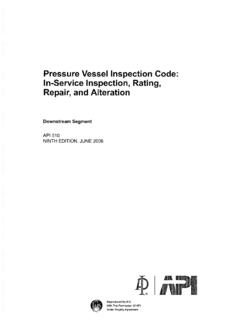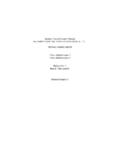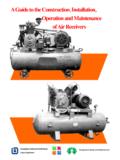Transcription of API 510 (2006): Pressure Vessel Inspection Code: In ...
1 Pressure Vessel Inspection code : In-Service Inspection , Rating, Repair, and Alteration Downstream Segment API 510 NINTH EDITION, JUNE 2006 1) Reproduced By IHS Wrth The Permission Of API Under Royalty Agreement SPECIAL NOTES API publications necessarily address problems of a general nature. With respect to particular circumstances, local, state, and federal laws and regulations should be reviewed. Neither API nor any of API's employees, subcontractors, consultants, committees, or other assignees make any warranty or representation, either express or implied, with respect to the accuracy, completeness, or usefulness of the information contained herein, or assume any liability or responsibility for any use, or the results of such use, of any information or process disclosed in this publication. Neither API nor any of API's employees, subcontractors, con-sultants, or other assignees represent that use ofthis publication would not infringe upon pri-vately owned rights.
2 API publications may be used by anyone desiring to do so. Every effort has been made by the Institute to assure the accuracy and reliability of the data contained in them; however, the Institute makes no representation, warranty, or guarantee in connection with this publication and hereby expressly disclaims any liability or responsibility for loss or damage resulting from its use or for the violation of any authorities having jurisdiction with which this publi-cation may conflict. API publications are published to facilitate the broad availability of proven, sound engineer-ing and operating practices. These publications are not intended to obviate the need for applying sound engineering judgment regarding when and where these publications should be utilized. The formulation and publication of API publications is not intended in any way to inhibit anyone from using any other practices. Any manufacturer marking equipment or materials in conformance with the marking requirements of an API standard is solely responsible for complying with all the applicable requirements of that standard.
3 API does not represent, warrant, or guarantee that such prod-ucts do in fact conform to the applicable API standard. All rights reserved. No part o/this work may be reproduced, stored in a retrieval system, or transmitted by any means, electronic, mechanical, photocopying, recording, or otherwise, without prior written permission from the publisher. Contact the Publisher, API Publishing Services, I220 L Street, N W, Washington, D. C. 20005. Copyright 2006 American Petroleum Institute FOREWORD In December 1931, API and the American Society of Mechanical Engineers (ASME) cre-ated the Joint APIIASME Committee on Unfired Pressure Vessels. This committee was cre-ated to formulate and prepare for publication a code for safe practices in the design, construction, Inspection , and repair of Pressure vessels to be used in the petroleum industry. Entitled APIIASME code for Unfired Pressure Vessels for Petroleum Liquids and Gases (commonly called the API/ASME code for Unfired Pressure Vessels or API/ASME code ), the first edition of the code was approved for publication in 1934.
4 From its inception, the APIIASME code contained Section I, which covered recommended practices for Vessel Inspection and repair and for establishing allowable working pressures for vessels in service. Section I recognized and afforded well-founded bases for handling various problems associated with the Inspection and rating of vessels subject to corrosion. Although the provisions of Section I (like other parts of the API! ASME code ) were origi-nally intended for Pressure vessels installed in the plants of the petroleum industry, espe-cially those vessels containing petroleum gases and liquids, these provisions were actually considered to be applicable to Pressure vessels in most services. ASME's boiler and Pres-sure Vessel Committee adopted substantially identical provisions and published them as a nonmandatory appendix in the 1950, 1952, 1956, and 1959 editions of Section VIII of the ASME boiler and Pressure Vessel code .
5 After the APII ASME code was discontinued in 1956, a demand arose for the issuance of Section I as a separate publication, applicable not only to vessels built in accordance with any edition of the APIIASME code but also to vessels built in accordance with any edition of Section VIII of the ASME code . Such a publication appeared to be necessary to assure industry that the trend toward uniform maintenance and Inspection practices afforded by Section] of the API! ASME code would be preserved. API 510, first published in 1958, is intended to satisfY this need. The procedures in Section] of the 1951 edition of the APIIASME code , as amended by the March 16, 1954 addenda, have been updated and revised in API 510. Section I of the API! ASME code contained references to certain design or construction provisions, so these ref-erences have been changed to refer to provisions in the AS ME code . Since the release of the 1960 edition of the National Board Inspection code , elements of the APlIASME code have also been carried by the National Board Inspection code .
6 It is the intent of API to keep this publication up to date. All Pressure Vessel owners and operators are invited to report their experiences in the Inspection and repair of Pressure ves-sels whenever such experiences may suggest a need for revising or expanding the practices set forth in API 510. This edition of API 510 supersedes all previous editions of API 510. Each edition, revision, or addenda to this API standard may be used beginning with the date of issuance shown on the cover page for that edition, revision, or addenda. Each edition, revision, or addenda to this API standard becomes effective 6 months after the date of issuance for equipment that is rerated, reconstructed, relocated, repaired, modified (altered), inspected, and tested per this standard. During the 6-month time between the date of issuance of the edition, revision, or addenda and the effective date, the user shall specifY to which edition, revision, or addenda, and the equipment is to be rerated, reconstructed, relocated, repaired, modified (altered), inspected and tested.
7 Nothing contained in any API publication is to be construed as granting any right, by impli-cation or otherwise, for the manufacture, sale, or use of any method, apparatus, or product covered by letters patent. Neither should anything contained in the publication be construed as insuring anyone against liability for infringement of letters patent. iii This document was produced under API standardization procedures that ensure appropriate notification and participation in the developmental process and is designated as an API stan-dard. Questions concerning the interpretation of the content of this publication or comments and questions concerning the procedures under which this publication was developed should be directed in writing to the Director of Standards, American Petroleum Institute, 1220 L Street, , Washington, 20005. Requests for permission to reproduce or translate all or any part of the material published herein should also be addressed to the director.
8 Generally, API standards are reviewed and revised, reaffirmed, or withdrawn at least every five years. A one-time extension of up to two years may be added to this review cycle. Status of the publication can be ascertained from the API Standards Department, telephone (202) 682-8000. A catalog of API publications and materials is published annually and updated quarterly by API, 1220 L Street, , Washington, 20005. Suggested revisions are invited and should be submitted to the Standards and Publications Department, API, 1220 L Street, NW, Washington, DC 20005, INSTRUCTIONS FOR SUBMITTING A PROPOSED REVISION TO THIS STANDARD UNDER CONTINUOUS MAINTENANCE This standard is maintained under APT's continuous maintenance procedures. These proce-dures establish a documented program for regular publication of addenda or revisions, including timely and documented consensus action requests for revisions to any part of the standard.
9 Proposed revisions shall be submitted to the Director, Standards Department, API, 1220 L Street, NW, Washington, 20005-4070, CONTENTS Page SCOPE .. 1-1 General Application .. 1-1 I .2 Specific Applications .. I-I Recognized Technical Concepts .. 1-2 2 REFERENCES .. 2-1 3 DEFINITIONS .. 3-1 4 OWNERIUSER Inspection ORGANIZATION .. 4-1 General..4-1 Owner/user Organization Responsibilities .. 4-1 5 Inspection , EXAMINATION AND Pressure TESTING PRACTICES .. 5-1 Inspection Plans .. 5-1 Risk-based Inspection (Rbi) .. 5-1 Preparation For Inspection .. 5-2 Inspection For Types Of Damage Modes Of Deterioration And Failure .. 5-3 General Types Oflnspection And Surveillance .. 5-4 Condition Monitoring Locations .. 5-7 Condition Monitoring Methods .. 5-7 Pressure Testing .. 5-9 Material Verification And Traceability .. 5-10 Inspection Ofln-service Welds And Joints .. 5-11 Inspection Of Flanged Joints.
10 5-11 6 INTERV ALiFREQUENCY AND EXTENT OF Inspection .. 6-1 General .. 6-1 Inspection During Installation And Service Changes .. 6-1 Risk-based Inspection .. 6-1 External Inspection .. 6-1 Internal And On-stream Inspection .. 6-2 Pressure -relieving Devices .. 6-3 7 Inspection DATA EVALUATION, ANALYSIS, AND RECORDING .. 7-1 Corrosion Rate Determination .. 7-1 Remaining Life Calculations .. 7-1 Maximum Allowable Working Pressure Determination .. 7-2 Fitness For Service Analysis Of Corroded Regions .. 7-2 API RP 579 Fitness For Service Evaluations .. 7-3 Required Thickness Determination .. 7-4 Evaluation Of Existing Equipment With Minimal Documentation .. 7-4 Reports And Records .. 7-5 8 REPAIRS, ALTERATIONS, AND RERATING OF Pressure VESSELS .. 8-1 Repairs And Alterations .. 8-1 Rerating .. 8-7 v CONTENTS Page 9 ALTERNATIVE RULES FOR EXPLORATION AND PRODUCTION Pressure VESSELS.









